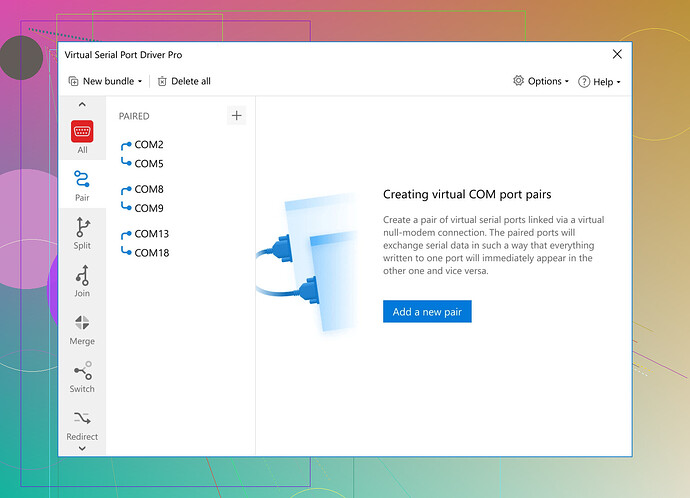I’m trying to emulate a serial port for a project, but I’m not sure how to get started. Can anyone guide me on the steps or recommend some tools? Any help would be appreciated!
Alright, if you’re trying to emulate a serial port for your project, here’s a straightforward guide to get you rolling. Serial port emulation can be super handy, especially when dealing with legacy systems or software that requires serial communication.
-
Understand the Basics: Before diving in, make sure you understand what a serial port is and how it works. Serial ports are communication interfaces that transmit data one bit at a time.
-
Choose Your Tools: For Windows, one of the best tools out there is Virtual Serial Port Driver. It allows you to create virtual serial ports and pair them, which can then be used just like real hardware ports.
-
Installation: Download and install the Virtual Serial Port Driver. The setup process is pretty straightforward. Follow the on-screen instructions.
-
Create Virtual Ports: Open the tool and use it to create virtual serial ports. You can typically choose the COM port numbers to use. These ports will function like real ones, allowing your software to communicate through them.
-
Testing: After setting up your ports, use terminal software like PuTTY or Tera Term to test the communication. You can send and receive data through the virtual ports to ensure they’re working correctly.
-
Configuration: Adjust the settings of the virtual ports as needed. This might involve setting baud rate, parity, stop bits, and other parameters to match what your application expects.
-
Integration with Your Project: Finally, integrate the virtual serial ports into your project. Ensure your application is set to use the COM ports you’ve created and configured.
For more detailed instructions or troubleshooting tips, I’d recommend reading this in-depth serial port emulator guide. It provides comprehensive steps and insights into optimizing legacy systems using serial port emulation.
And hey, if anything gets too confusing, there’s always the community here to help out. Feel free to ask more questions or share specific issues you run into. Happy emulating!
Hey there, serial port emulation sounds complicated, doesn’t it? But it’s totally doable. You’ve already got some great insights from @sognonotturno, but let me toss in a few additional ideas without overloading you with the same steps.
-
Alternative Tools: If you’re not on Windows, or just want to explore more options, check out com0com. It’s an open-source emulator for virtual serial ports on Windows. For Linux, look into socat or tty0tty. They can create virtual serial links quite efficiently.
-
Programming Languages: Depending on your project, you might want to leverage Python, especially with the
pyserialmodule. It’s excellent for creating and managing serial communications. Python, being so versatile, can also help you test your virtual setup. -
Using
socat: This is especially useful on Unix-like systems. Withsocat, you can create virtual serial port pairs like this:socat -d -d pty,raw,echo=0 pty,raw,echo=0This command sets up two pseudo-terminals that can be used as virtual serial ports.
-
Compatibility Considerations: Ensure that whatever tool you use is compatible with your operating system and the requirements of your project. Some of these tools might have quirks or limitations based on OS version.
-
User Forums and Documentation: Don’t underestimate the value of hopping into forums or diving deep into the documentation for these tools. Sometimes the most minor setting can trip you up, and community advice can save hours of frustration.
-
Testing with Real Devices: If possible, test your virtual setup with real devices to ensure a seamless transition. Tools like PuTTY, as mentioned, can help you emulate these tests. However, there are also specialized testing tools for specific communication protocols you might find handy.
Also, you might want to check out this highly-rated virtual serial port software. It simplifies the process and ensures you don’t waste time on more complicated setups.
Remember, emulating serial ports can feel tricky at first, but with the right tools and patience, you’ll have it running smoothly. If you hit a wall, forums like this are perfect for bouncing ideas off other enthusiasts.
Hey, just adding to what @ombrasilente and @sognonotturno already shared, let’s get into a few more specifics and explore some pros and cons.
So, if you’re looking for a seamless solution on Windows, the Virtual Serial Port Driver (VSPD) is a solid choice:
Pros:
- User-Friendly Interface: Easy setup with a GUI that simplifies creating virtual serial ports.
- Robust Functionality: Handles various configurations well, ensuring compatibility with legacy software.
- Support and Documentation: Decent support and comprehensive guides available.
Cons:
- Cost: It’s not free, so factor that into your budget.
- Windows-Only: Limited to Windows, leaving Linux users needing alternatives like
socat.
But let’s dive a bit more deeply, especially for those on a Linux system:
-
socat Setup: In Linux, using
socatis a powerful way to emulate serial ports. For instance,socat -d -d pty,raw,echo=0 pty,raw,echo=0This command links two pseudo-terminal devices that can act like serial ports.
-
Python with pyserial: Regardless of your OS, leveraging Python with the
pyserialmodule can ease the process. It’s straightforward to handle reading from and writing to the serial ports. -
Testing with minicom: On Linux, tools like
minicomcan be used to interact with these ports for testing purposes. This ensures your setup works before integrating it into your main project.
Don’t overlook the compatibility and support nuances. For instance, while com0com is great on Windows and open-source, getting it up and running can be a bit more hands-on. tty0tty is a good Linux substitute, but again, each tool has its quirks based on OS versions and updates.
If you’re a fan of visual interfaces, VSPD excels with its straightforward design. But if you’re more comfortable with command-line operations, probably stick to socat or similar tools.
Got more questions or hit a snag? Keep them coming. There’s always a workaround or a tip someone else can share. Happy emulating!
